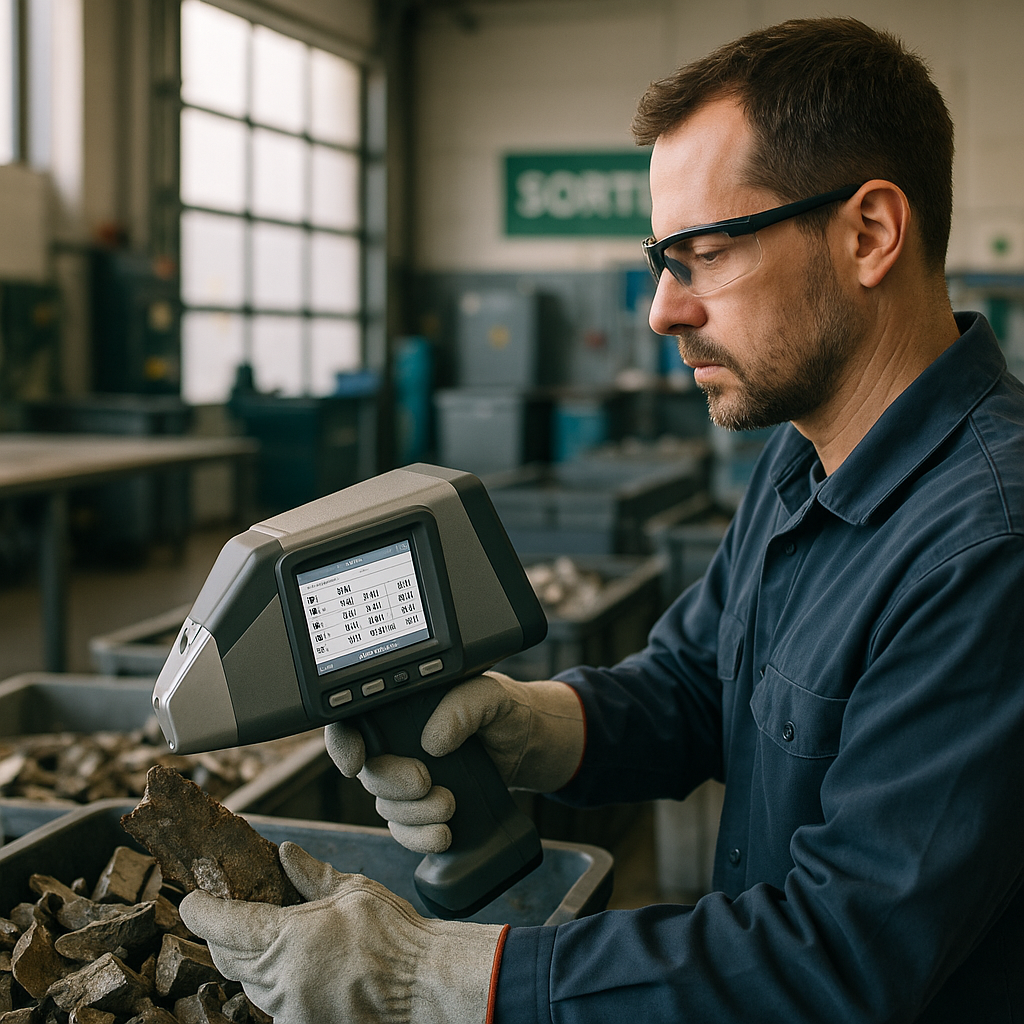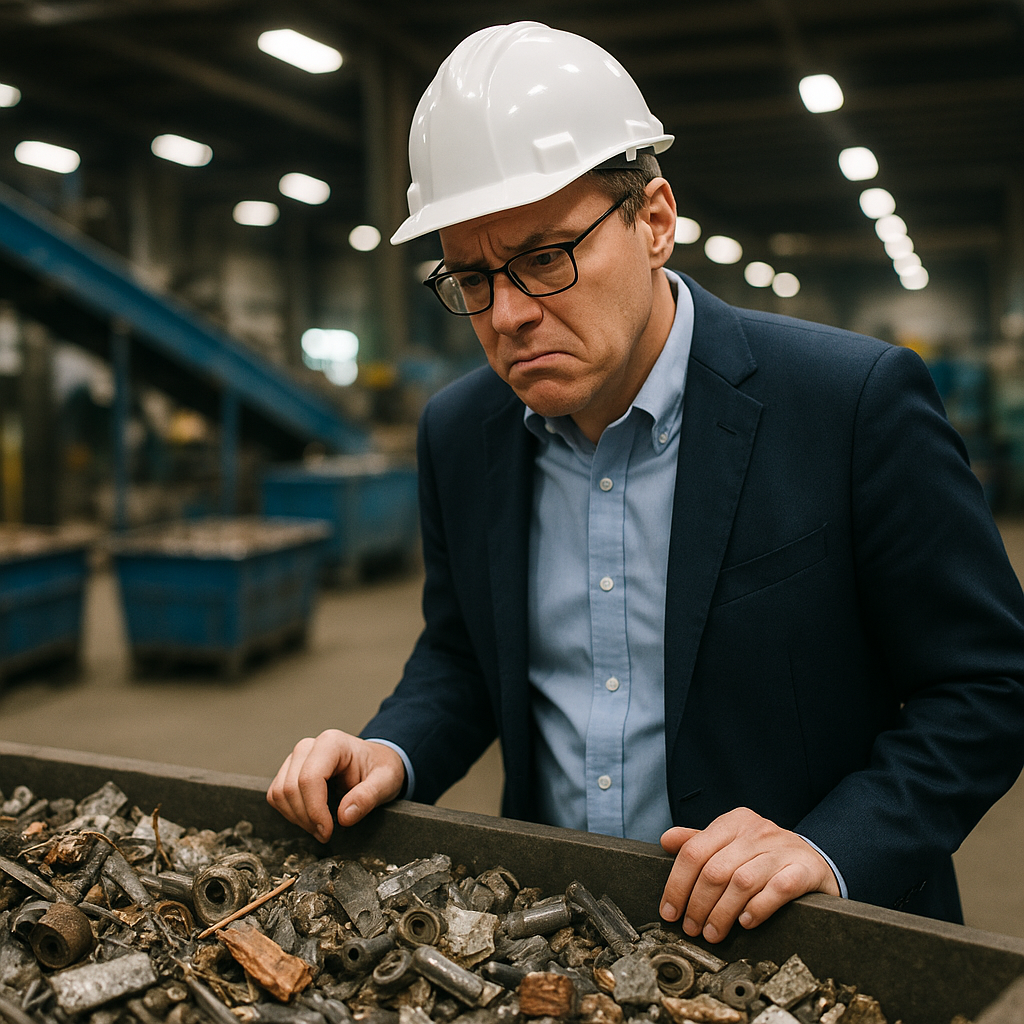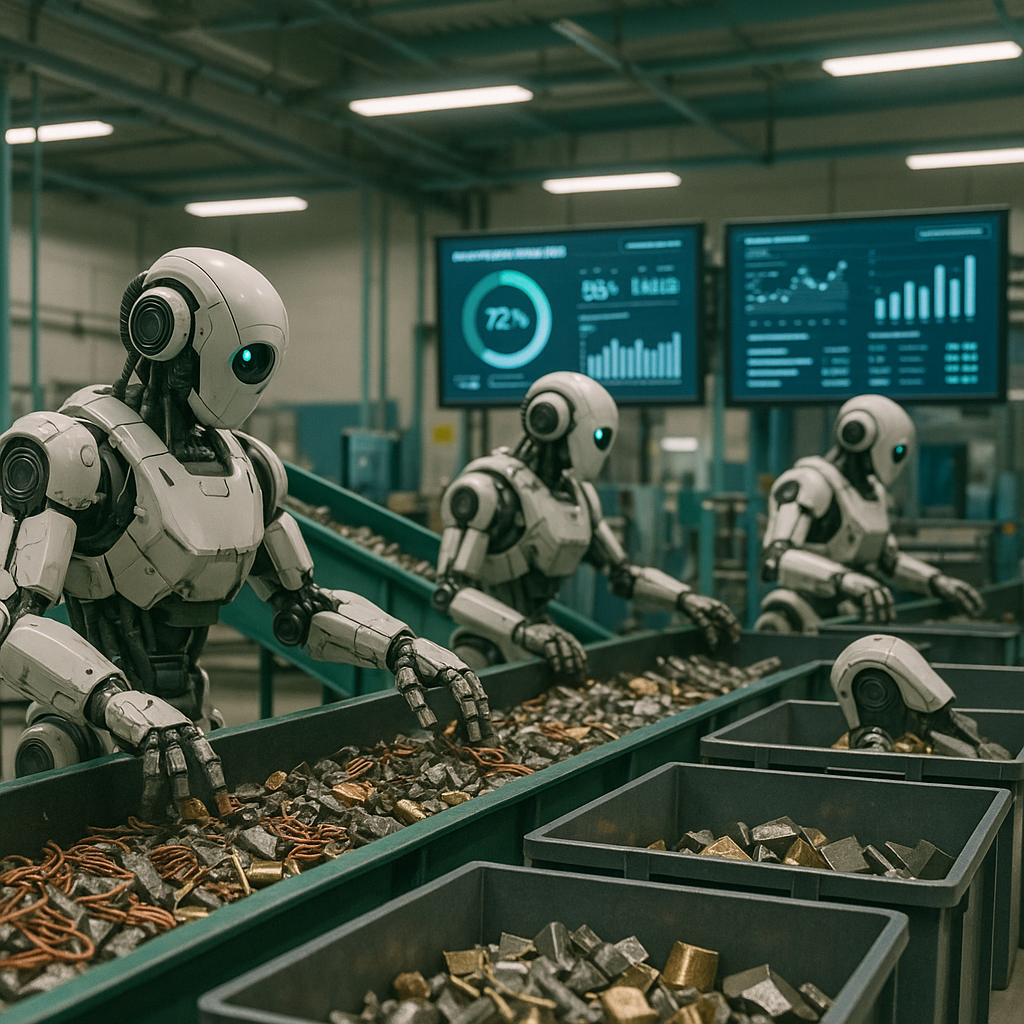5901 Botham Jean Blvd, Dallas, TX 75215
Quality Control in Metal Recycling: Ensuring Purity, Precision, and Performance in Recycled Metals
October 17, 2025The value of recycled metal hinges on one critical factor: quality control. Without proper quality assurance measures, recycled metals can retain impurities that compromise their structural integrity, making them unsuitable for manufacturing purposes. Quality control in metal recycling involves systematic procedures and technologies to ensure recycled metals meet strict industry standards for purity and performance.
Metal recycling quality control begins with meticulous sorting processes. Recyclers separate metals by type—aluminum, copper, steel, and others—using both visual inspection and advanced technologies like magnetic separators and infrared scanning. This step prevents cross-contamination between different metal types, a common issue that can significantly reduce the quality of the final product.
After sorting, the processing stage involves cutting, shredding, and preparing metals for melting. Each step in this sequence requires careful monitoring to maintain quality standards. When metals reach the melting phase, furnaces heat them to precise temperatures calibrated for each specific metal type. The melting process can take anywhere from minutes to hours, depending on the metal’s properties and the quantity being processed.
What Are the Key Steps in Metal Recycling Quality Control?
Quality control in metal recycling ensures that recycled materials meet industry standards and customer specifications. The process follows four essential steps that transform scrap metal into valuable resources for manufacturing. Each step requires specific technology and expertise to maximize recovery and maintain quality.
Sorting and Material Identification
The first critical step in metal recycling quality control is proper sorting and material identification. Recycling facilities use advanced technologies to separate metals by type and purity level. Magnetic separators efficiently divide ferrous metals like steel and iron from non-ferrous metals such as aluminum and copper.
For more precise identification, many facilities employ X-ray fluorescence (XRF) analyzers that identify the exact composition of metal alloys. Crossbelt magnetic separators automatically remove ferrous materials from conveyor lines, while eddy current separators use magnetic fields to sort non-ferrous metals based on conductivity properties.
Workers also conduct visual inspections to identify different metals by their color and weight characteristics. Copper appears yellowish-red, while aluminum has a distinctive silver color. This careful sorting process ensures that metals remain uncontaminated before moving to the next stage.
Shredding and Processing
Once sorted, metals undergo shredding and processing to reduce them to manageable sizes. Hydraulic machinery applies tremendous pressure to cut large metal pieces into smaller fragments. These machines use pressurized fluid systems that generate enough force to slice through thick metal components.
The FINGER-SCREEN™ technology uses high-frequency vibrating screens to separate fine materials from larger pieces. Hammer mills then further shred the metal into even smaller fragments. This step creates a larger surface-to-volume ratio, making the subsequent melting process more efficient and energy-effective.
Metal pieces are also compacted and baled to save space during transportation. DE-STONER® equipment removes unwanted light materials like plastic from recovered scrap metal during this phase, further improving the quality of the processed metal.
| Equipment | Function |
|---|---|
| CNC Machine | Processes metal with coded instructions for punching, cutting, and stamping. |
| Press Brakes | Bends metal sheets to specified angles. |
| Plate Rolls | Roll metal sheets into round or conical shapes. |
| Shears | Cut metal sheets into specified sizes. |
| Turret Punch | Punch holes across large metal areas. |
| Ironworkers | Multi-function machines for punching, notching, and shearing. |
| Band Saws | Cut solid metal pieces like blocks or profiles. |
| Lasers (Fiber/CO2) | Cut metal sheets or tubes. |
| Hydraulic Press Brake | Bends sheet metal into precise shapes. |
Purification
The third step focuses on removing contaminants to produce high-quality recycled metal. After shredding, metals are melted in large furnaces set to specific temperatures based on the metal type. Different metals require different heat levels due to their unique properties.
Purification methods vary depending on the metal. Electrolysis is a common technique where an electric current passes through the metal. The pure metal deposits at the cathode while impurities dissolve, collecting as “anode mud” at the bottom. This process is particularly effective for copper and aluminum purification.
Chemical fluxes added to molten metal help separate impurities and form slag that can be easily removed. Degassing techniques remove dissolved gases like hydrogen or nitrogen that could otherwise cause defects in the final product. These purification methods ensure the recycled metal meets the stringent requirements of industries such as aerospace, automotive, and construction.
Output Verification and Quality Testing
The final step involves verifying that the processed metals meet quality standards before they reach manufacturers. Recycling facilities use several testing methods to confirm metal composition and purity. X-ray Fluorescence (XRF) analysis provides precise information about the metal’s chemical makeup.
Inline metal composition testing continuously monitors the quality of recycled metals during production. These tests check for contaminants and verify that the metal meets industry specifications. Some facilities also use spectroscopy to analyze the light spectrum reflected by metals, revealing their exact composition.
After quality verification, the purified metals solidify into standardized shapes such as ingots, billets, or sheets, making them easier to transport and use in manufacturing. By ensuring consistent quality through rigorous testing, recycling facilities provide manufacturers with reliable materials that perform as well as virgin metals while offering significant environmental benefits.
How Does Technology Enhance Quality Control in Metal Recycling?

Advanced technologies have transformed quality control processes in metal recycling. Modern recycling facilities now use sophisticated equipment to detect, analyze, and sort metals with unprecedented precision. This technological advancement ensures higher purity levels in recycled metals while significantly increasing processing efficiency.
X-ray Fluorescence (XRF) analyzers lead this advancement. These powerful devices emit X-rays that cause atoms in metal samples to release unique energy signatures. Within seconds, recyclers can identify exact metal compositions and detect unwanted contaminants. Handheld XRF units enable rapid on-site testing, allowing recyclers to immediately assess material quality and value.
Inline testing systems further this by integrating composition analysis directly into the production line. Instead of testing random samples, these automated systems continuously monitor metal purity throughout the recycling process. Real-time data collection helps operators instantly identify quality issues, reducing waste and ensuring consistent output quality.
Vibrating equipment is crucial for material preparation and sorting. These systems use controlled vibration to separate materials based on density and size, helping remove non-metallic contaminants and ensuring uniform material flow into downstream processing equipment.
Specialized separators enhance sorting precision through various mechanisms. Magnetic separators extract ferrous metals from mixed streams, while eddy current separators target non-ferrous metals like aluminum and copper. These automated sorting technologies significantly increase recovery rates and material purity.
High-frequency screens further refine the sorting process by accurately classifying materials by size. These screens operate at higher speeds than conventional equipment, handling large volumes of recycled metal efficiently. The precise sizing capabilities ensure that metals meet strict industry specifications.
Integrating these technologies creates a comprehensive quality control system that monitors metal purity at every stage of recycling. This approach offers multiple benefits: higher-quality recycled metals, reduced processing costs, decreased energy consumption, and minimized environmental impact.
By adopting these advanced technologies, metal recyclers can meet increasingly stringent quality requirements while maintaining profitable operations, resulting in a more efficient recycling industry producing high-value secondary metals for manufacturing.
What Are the Challenges in Metal Recycling Quality Control?

Quality control in metal recycling involves maintaining consistent output quality amidst diverse input streams, presenting substantial challenges. These, however, are spurring innovations that enhance the recycling ecosystem.
Mixed Material Inputs
The variability of incoming scrap is a fundamental challenge for recycling operations. Scrap metal typically arrives as a mix of different alloys, grades, and material compositions, often including aluminum, copper, steel, and other metals with varied properties.
This complexity makes accurate sorting crucial yet challenging. Without proper segregation, recycled materials may exhibit inconsistent quality or unpredictable properties. Many facilities now implement advanced sorting technologies like X-ray fluorescence (XRF) and magnetic separators to address this issue.
Mastering mixed material handling provides a competitive advantage. For example, modern recycling facilities use AI-powered sorting systems that identify and separate various metal types with remarkable precision, turning a limitation into an opportunity for material recovery excellence.
Contaminant Removal
Contamination is one of the most persistent quality control issues in metal recycling. Non-metallic materials such as plastics, rubber, or hazardous substances often accompany scrap metal and must be removed before processing.
Even minor contamination can compromise entire batches. For instance, trace amounts of copper mixed with steel can significantly alter the recycled material’s properties, making it unsuitable for high-grade applications. Chemical contaminants from coatings or treatments add further complexity.
Progressive recycling operations transform this challenge into an opportunity by developing specialized pre-treatment methods like washing, degreasing, and chemical treatments to neutralize contaminants before they affect final product quality. These innovations not only improve material purity but also open new markets for higher-value recycled metals.
Meeting Industry Standards
The need for recycled metal to match or exceed the properties of virgin metals is growing. Meeting stringent industry standards requires sophisticated quality control systems and consistent testing protocols.
Specifications from ASTM International or industry-specific requirements establish precise guidelines for chemical composition, mechanical properties, and performance. Achieving these benchmarks with variable input materials is challenging for recyclers.
Forward-thinking companies are implementing comprehensive testing regimes throughout their processes. By conducting regular analysis and adjustments in real-time, they maintain quality consistency, turning compliance into a value proposition. This enables them to serve premium markets with certified, high-quality materials.
Environmental Concerns
Quality control in metal recycling also involves addressing environmental concerns. Processing scrap can produce emissions, wastewater, and byproducts that must be managed to meet environmental regulations.
The challenge extends beyond compliance to sustainability goals. Recyclers must minimize their environmental footprint while maximizing material recovery rates, requiring sophisticated monitoring systems and pollution control technologies.
Leading recycling facilities are turning environmental challenges into opportunities for innovation by implementing closed-loop water systems, energy-efficient processing, and advanced emission controls, creating cleaner operations that appeal to environmentally conscious customers and communities.
Balancing Thoroughness with Efficiency
Perhaps the most nuanced challenge is balancing thoroughness with operational efficiency. Rigorous quality control typically involves more time, energy, and resources for each ton of material.
In an industry with thin margins, extensive quality control can be costly. Nonetheless, cutting corners results in inferior products, rejected shipments, and damaged customer relationships, creating pressure to optimize processes.
Innovative recyclers tackle this challenge with automation and data analytics. By deploying sensors and analyzing data streams, they identify areas where quality issues emerge, allowing precise interventions without slowing down the process, thus maximizing both quality and throughput.
| Challenge | Innovative Solution |
|---|---|
| Mixed Material Inputs | Advanced sorting technologies like X-ray fluorescence and magnetic separators |
| Contaminant Removal | Pre-treatment methods, including washing systems and chemical treatments |
| Meeting Industry Standards | Comprehensive testing regimes and real-time adjustments |
| Environmental Concerns | Closed-loop water systems and energy-efficient processing equipment |
| Balancing Thoroughness with Efficiency | Automation and data analytics for optimized processes |
The Technology Factor
Technology adoption poses both a challenge and an opportunity in recycling quality control. New sorting and purification technologies can significantly improve output quality but require considerable investment and skilled operators.
Smaller recycling facilities often struggle to afford advanced equipment like X-ray transmission scanners or laser-induced breakdown spectroscopy systems, creating disparities in the industry’s quality control capabilities.
However, technological innovation continues to propel the industry forward. Equipment manufacturers are developing more affordable solutions, while industry partnerships make advanced technologies accessible to a broader range of recyclers, pointing toward a future where high-quality control becomes the standard.
Conclusion: The Future of Quality Control in Metal Recycling

As demand for recycled metals grows, quality control remains crucial to the metal recycling industry’s success. Advanced technologies such as X-ray fluorescence (XRF), laser-induced breakdown spectroscopy, and AI-driven sorting systems are transforming how recycled metals are processed and verified. These innovations ensure consistent quality and performance while greatly reducing contamination risks that once hindered market acceptance.
These technological advancements not only enhance operational efficiency but also transform recycled metals into materials that meet or exceed industry standards. This quality transformation allows recycled metal to compete directly with virgin materials in demanding applications across aerospace, automotive, and electronics manufacturing. The result is a true circular economy where resources remain in productive use rather than depleting natural reserves.
Contact Okon Recycling at 214-717-4083 for your recycling needs and partner with a company that understands the critical importance of quality control in creating sustainable material streams for future manufacturing needs.
